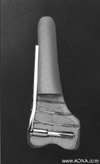Introduction to the Dynamic Condylar Screw-DCS

Click for enlarged view of image
The Dynamic Condylar Screw is designed to provide
strong and stable internal fixation of certain distal
femoral and subtrochanteric fractures, with minimal
soft tissue irritation.
Strong
-
The DCS Plates are made of 316L stainless steel and
are cold-worked for strength.
Stable
-
The two holes closest to the barrel accept 6.5 mm
Cancellous Bone Screws. This enhances stability
by allowing:
· fixation of the most distal condylar fracture
fragments
with two or more screws, or
· fixation of the most proximal subtrochanteric
fracture fragment
with two or more screws.
-
DCP holes in the DCS side plate allow angulation of
4.5 mm Cortex Screws and axial compression across
a shaft fracture.
- The number of screw holes per plate length is maxi-
mized, without compromising plate strength. This
allows an increased number of fixation points with
a smaller incision.
- Two flats within the DCS Plate barrel correspond to
the two-flat design of the lag screw, preventing rota-
tion of the DHS/DCS Lag Screw within the barrel.
The two-flat design also eases insertion of the plate
over the DHS/DCS Lag Screw.
Minimal Soft Tissue Irritation
- Low-profile design reduces risk of iliotibial band
irritation (distal femoral fractures) and trochanteric
bursitis (subtrochanteric fractures).
The DCS Plates are available with 6 to 16 holes, for
varied clinical situations. The DHS/DCS Lag Screw is
available in 50 mm to 145 mm lengths. The DHS/DCS
Compressing Screw can be used for additional compression; only one size compressing screw is needed.
The DCS instruments also provide direct measurements throughout the DCS procedure, allowing proper
reaming, tapping, and lag screw insertion depth. The
built-in stop and locking nut on the DCS Triple
Reamer prevent over-reaming.
Next Page
DHS / DCS Index

